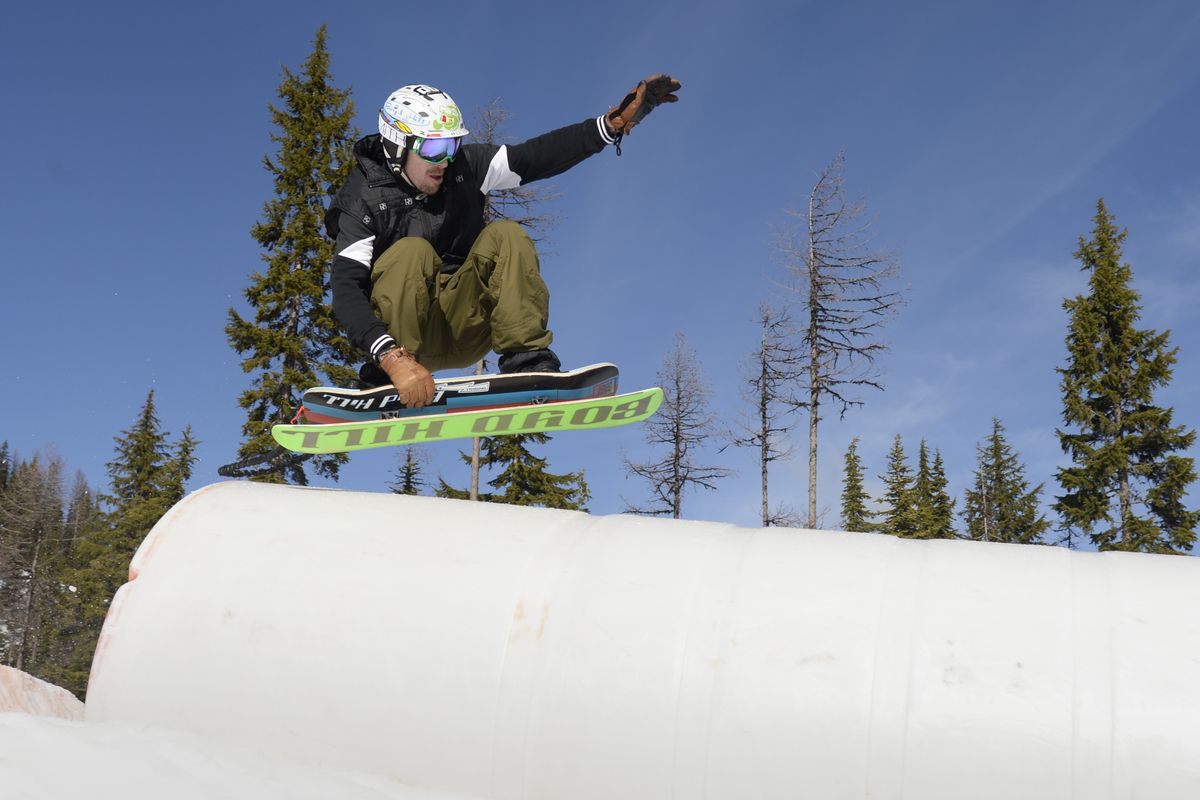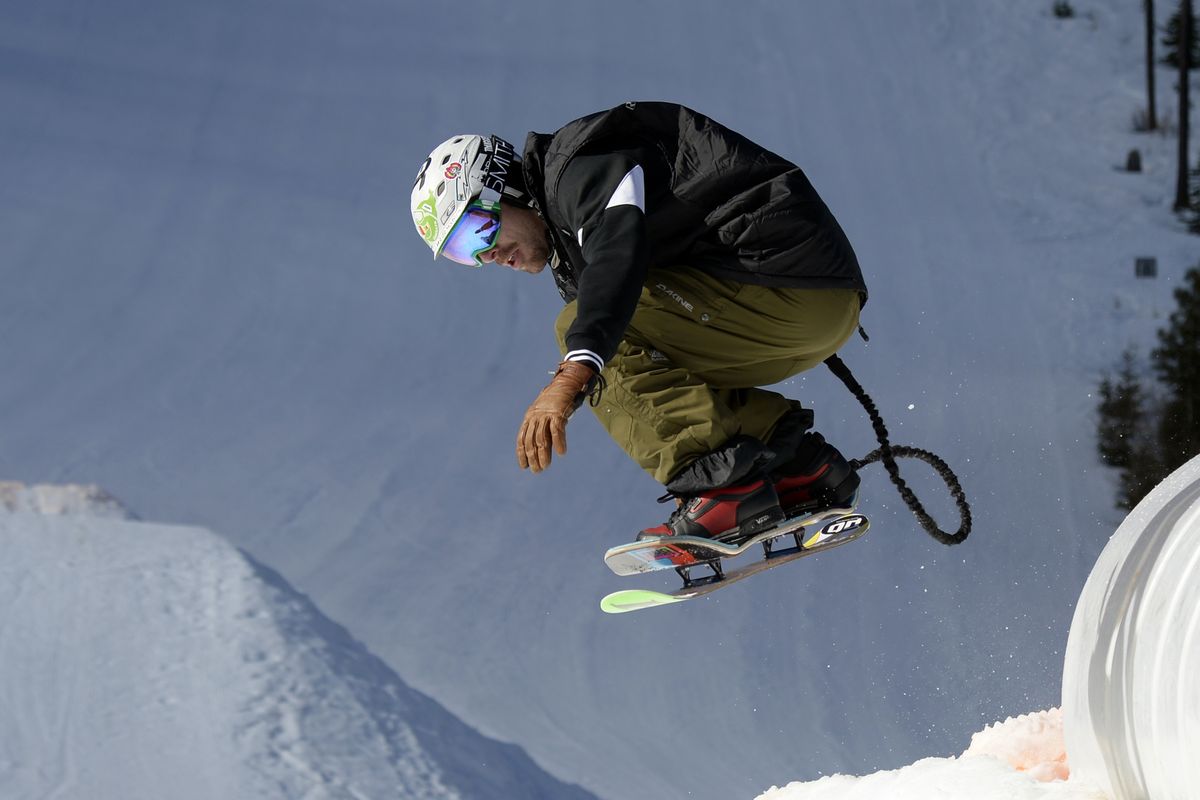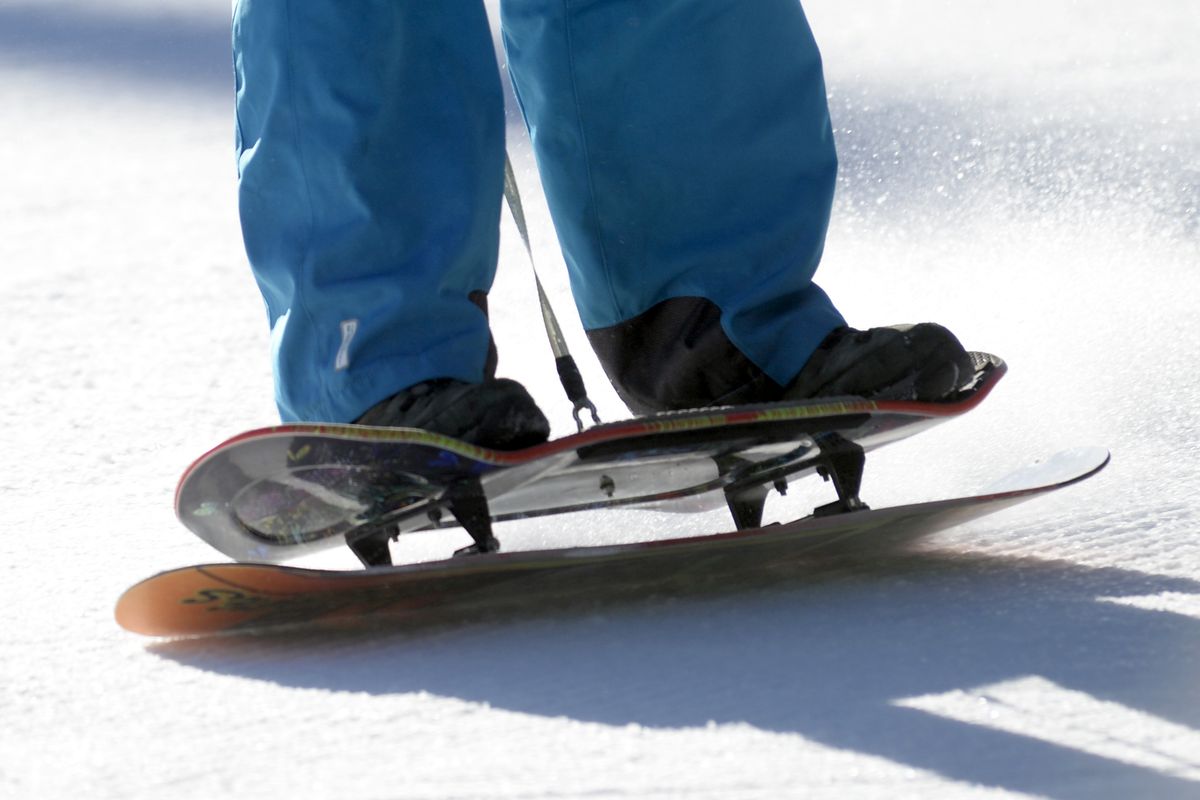Snowskating sparks binding-free revolution, a roots revival
The binding-free movement has arrived. Wacey Loe wears only insulated skate shoes as he takes off a jump at Silver Mountain. (Jesse Tinsley)Buy a print of this photo
Silhouettes emerge in the periphery of the fog, take shape only long enough to be passed by. A small snow hill appears, and Boyd Hill snowskater Wacey Loe takes it in stride.
Loe lands and steers toward another feature. Snow hums underneath his ski. A couple of more feet of suspended air provide an interlude to this downhill anthem. Loe adds another jump to the sequence, then finally pulls off a pop shove-it without ever breaking rhythm.
He stops and, without unstrapping any sort of binding, kicks up his board – a bideck snowskate. The logo “Boyd Hill” adorns the bottom of the ski, which is approximately 60 percent the size of a snowboard. Atop it, attached by a pair of aluminum trucks, sits an oversized skateboard covered in ice- and snow-resistant foam grip tape.
The only thing keeping Loe atop his board is his sense of balance, his ability to adjust his weight and foot position. He wears a leash attached below the knee to ensure he will not lose his board should he step off abruptly or fall.
A lack of binding offers more opportunities for improvisation, while the raised design affords a new vantage point to a streaming sheen of frost, a blur of powder.
“It makes the mountain a lot bigger,” said T.J. Sneva, owner of Sneva Mfg. in Spokane.
Sneva has been designing and manufacturing custom alpine skies for more than 20 years. He has been with Boyd Hill Snowskates since the company’s inception 6 years ago.
“Maybe you have been skating a mountain for 10 years,” he said, “but then you jump on a snowskate and it’s something entirely new.”
It was just 28 years ago when snowboarders first started showing up at local mountain slopes.
Some skiers met these strangers with genuine curiosity and interest, while others blamed them for ruining their runs, messing their moguls.
Some snowboarders were drawn by comparisons of surfing, skateboarding – promises of achieving something similar, but on snow. Along with their expectations, these new powder hounds brought a new attitude, a plan to test limits.
Snowboarding added an alternative vernacular to the mountain, a new style. In 1998, it became an Olympic sport. Along that route some claimed the sport lost its identity. A sense of subversion was gone.
“When snowboarding first came out, people were told it was skateboarding on snow,” said Bryce Rich of Coeur d’Alene, owner and CEO of Boyd Hill Snowskates. “Everybody quickly realized snowboarding has never been skateboarding on snow.
“There’s a million kids who skateboard, but it’s never once been considered for the Olympics,” Rich said. “The type of people that would compete would feel that the sport would lose its soul.”
Rich views snowskating’s binding free movement not only as a fresh way to ride, but also a revival of skating’s core roots.
These are athletes who don’t care to have their creativity quantified, their innovation measured. This is a sport meant to break measure, ignore the boundaries of scales, mash octaves.
Snowskating – this is the return to mountain soul.
“Everybody sees the potential in the sport, everybody sees where it could go next, everybody wants to be on this cusp before it blows up,” Rich said. “This is 1989 snowboarding right now. … If you look back, you think about what it was like back then – you saw two snowboards one day on the mountain. One shop in town sold two types of snowboards. Everyone is gambling with that – we think we’re on the cusp of something big.”
For as long as people have been riding chairlifts, skateboarder enthusiasts have been seeking a way to translate their sport to snow. Premier Snowskates manufactured and marketed a single deck snowskate – a skateboard with grooves in the bottom-side instead of trucks and wheels – the same year snowboarding hit the Olympic scene – 1998.
Single decks have never fared well in mountain conditions, however, as they are meant primarily for parks, performing tricks off curbs and rails.
Stevens Pass Resort ski school director Steve Frink is credited with inventing the bideck in the early 2000s. About that same time, Burton introduced their version, the “Snowdeck.” Since then, several improvements have been made by numerous companies.
Aside from the single deck and the bideck, two other forms exist: the 4x4, in which four small skies replace wheels, and the powderskate.
“The powderskates are a lot easier to control,” Loe said. “It’s a lot like surfing – you’re just floating. That’s every snowskater’s dream – to surf on the powder.”
Several years ago, Rich worked with his own snowskate designs on Boyd Avenue in Coeur d’Alene. Whenever the street closed after a snowfall for sledding, Rich would test out his latest attempt. The company chose to takes its name from its birthplace.
Rich met with Sneva in 2008 and proposed an idea: a team effort, a localized strategy. With numerous locations nearby and access to a variety of slopes, they could push the boundaries of snowskating, retool as necessary, to perfect every situation of powder.
“My first day up, my first batch of snowskates, I expected a long day of waiting around,” Sneva said. “I ripped through some trees and these guys are riding 100-centimeter skies and keeping up with an alpine skier. It was pretty impressive.”
Sneva works out of his home on the South Hill, putting in 12- to 14-hour days seven days a week. He builds approximately 1,000 pairs of skies a year. Forty percent of his work is snowskates. Rich joins him in the evenings, after his work as Red Bull premise manager with Hayden Beverage.
“Five or six years ago, there was pretty much one ski,” Sneva said. “Now we’re at a point where we’re building a specific snowskate. With the evolution of alpine skies, we’re also putting that technology into snowskates.”
“We’ve developed specific cambers just for snowskating,” said Rich. “The same rules (as snowboarding) don’t apply. … We’re not using traditional cambers or rockers.
“The real advantage to manufacturing locally is if you come to me with an idea, we can go prototype it tomorrow. We’ll be on the snow on that board in a week, whereas if you had something manufactured overseas, you’ll see it next year.”
Boyd Hill Snowskates sells mostly direct.
“We want to change how skies are bought and sold,” Rich said.
Business continues to pick up nationally and internationally, as buyers hail from as far as Australia, Norway, French Canada and upstate New York, where certain mountain resorts are becoming the first to offer snowskates in their rental fleet.
Locally, Boyd Hill demoes their snowskates as often as possible. While they don’t have a retail space, they encourage interested parties to like them on Facebook, or contact them on their website: Boydhill.com.
“Our best marketing tool for us is to get people physically on them,” Rich said.
Loe works as a cook at the lodge on Silver Mountain and always leaves a couple of snowskates outside the kitchen for anyone to try.
“People always ask the same three questions,” he said.
“‘What is that? Did you invent? Where can I get one?’ ”
“The joke is the worst part of snowskating is having to talk to everybody,” Rich said.
All snowskating requires is a decent of balance. An aversion to going fast need not apply, as speed is your friend and what makes the nose turn. A wide stance, square shoulders and a heavy front foot, the rear foot for steering, is how Loe recommends starting out.
“It’s about finding that sweet spot,” Rich said.
Loe recalled a mother with skis that asked to try his snowskate and did incredible her first run down the bunny hill at Silver Mountain.
“She said it was the coolest thing since Nintendo,” he said.
Rich recommends all potential snowskaters get their start on the bunny hill, until they are comfortably able to ride on and off a chairlift.
Since chairlifts are not insured for foot traffic, snowskaters temporarily attach their front foot to the board with an elastic band when riding on and off. This is important to ensure snowskating remains compliant at local resorts like Silver Mountain, Schweitzer, Lookout Pass. (A complete listing of local resorts that allow snowskating is available at Boydhill.com.)
On Feb. 28, Boyd Hill is hosting a snowskating event at Lookout Pass called SortaNatural, complete with cheap lift tickets, raffles, giveaways and, of course, demos. For more details, check them out on Facebook.
“We’ve got snowskaters coming from New Mexico, a bunch of west siders. We’ve got some Canadians coming down,” Rich said. “We’ll probably take over the town of Wallace.”



